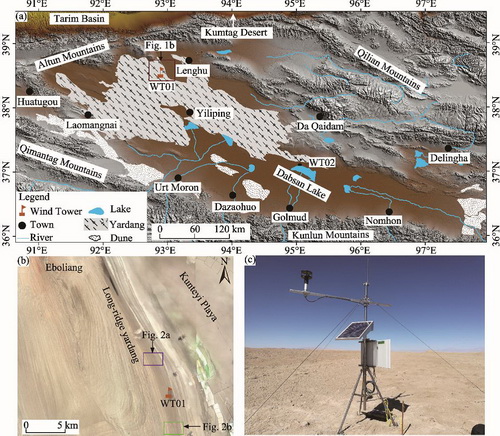Scientists Analyze the Wind Regime for Long-Ridge Yardangs in the Northwestern Qaidam Basin
Updatetime:2019-11-11From:
【Enlarge】【Reduce】
Yardangs are typical aeolian erosion landforms in arid and semi-arid regions, which are sculpted by a combination of aeolian erosion, fluvial erosion, weathering, mass movement and corrosion.
The yardang landforms in Qaidam Basin are the largest and are with the highest elevation in China. The typical long-ridge yardangs distributed in this region, so the yardang landforms in Qaidam Basin have important reference value for geomorphic research.
However, there are still much dispute remains to be determined about the formation mechanisms of yardangs in Qaidam Basin.
Recently, a research group from Northwest Institute of Eco-Environment and Resources (NIEER) of the Chinese Academy of Sciences installed wind observation tower in the field to clarify the influence of aeolian environments to the development of long-ridge yardangs in the northwestern Qaidam Basin of China.
The results from observation showed that the sand-driving winds mainly blew from the north-northwest, northwest and north directions, and were the severest in summer and spring.
The annual drift potential and the ratio of resultant drift potential indicate that the study area pertains to an extremely high-energy wind environment and a narrow unimodal wind regime.
Therefore, the strong and unidirectional wind regime created and subsequently shaped the long-ridge yardangs in the northwestern Qaidam Basin which can be attributed to a combination of the topographic obstacle.
This study clarifies the wind regime corresponding to the long-ridge yardangs’ development, and lays firm foundation to put forward the formation mechanisms for yardangs in the Qaidam Basin.
The study result was published InJouranl of Arid Land.

(a) Location and physiographic setting of the Qaidam Basin, and the location of wind observation tower and yardangs; (b) Google Earth image of the landforms surrounding wind tower WT01; (c) The ground surface characteristics surrounding the wind observation tower WT01. (Image by GAO Xuemin)
Contact:
GAO Xuemin
waipoqiaoqt@163.com
Key Laboratory of Desert and Desertification, Northwest Institute of Eco-Environment and Resources, Chinese Academy of Sciences, Lanzhou 730000, China.
Appendix




